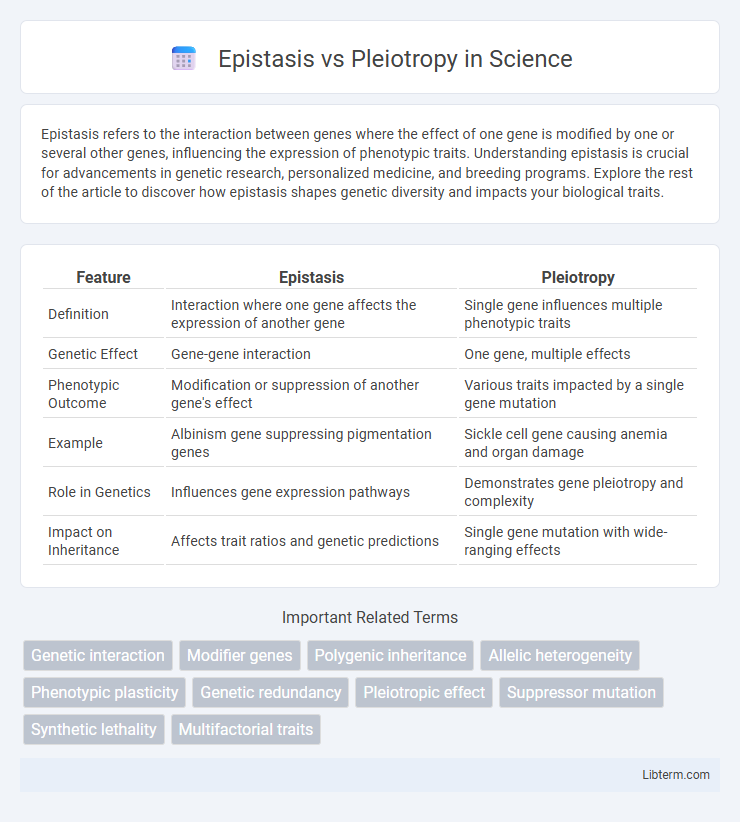Epistasis refers to the interaction between genes where the effect of one gene is modified by one or several other genes, influencing the expression of phenotypic traits. Understanding epistasis is crucial for advancements in genetic research, personalized medicine, and breeding programs. Explore the rest of the article to discover how epistasis shapes genetic diversity and impacts your biological traits.
Table of Comparison
| Feature | Epistasis | Pleiotropy |
|---|---|---|
| Definition | Interaction where one gene affects the expression of another gene | Single gene influences multiple phenotypic traits |
| Genetic Effect | Gene-gene interaction | One gene, multiple effects |
| Phenotypic Outcome | Modification or suppression of another gene's effect | Various traits impacted by a single gene mutation |
| Example | Albinism gene suppressing pigmentation genes | Sickle cell gene causing anemia and organ damage |
| Role in Genetics | Influences gene expression pathways | Demonstrates gene pleiotropy and complexity |
| Impact on Inheritance | Affects trait ratios and genetic predictions | Single gene mutation with wide-ranging effects |
Introduction to Epistasis and Pleiotropy
Epistasis occurs when one gene's expression masks or modifies the effect of another gene at a different locus, influencing phenotypic traits in complex genetic interactions. Pleiotropy refers to a single gene affecting multiple, seemingly unrelated phenotypic traits, demonstrating the gene's widespread influence across biological functions. Both concepts are critical in understanding genetic architecture and the mapping of genotype to phenotype in organisms.
Defining Epistasis: Gene-Gene Interactions
Epistasis refers to gene-gene interactions where one gene's expression masks or modifies the effect of another gene at a different locus, impacting phenotypic traits and genetic pathways. This interaction plays a critical role in complex traits, influencing how multiple genes collectively contribute to observable characteristics. Understanding epistasis is essential for interpreting genetic variation, disease susceptibility, and evolutionary biology.
Understanding Pleiotropy: One Gene, Multiple Effects
Pleiotropy occurs when a single gene influences multiple phenotypic traits, reflecting the gene's diverse roles in biological processes. This phenomenon is crucial in understanding genetic disorders where one mutation leads to various clinical symptoms, such as Marfan syndrome caused by mutations in the FBN1 gene. Studying pleiotropy enhances insight into gene function complexity and its impact on organismal development and disease.
Molecular Mechanisms Behind Epistasis
Epistasis occurs when one gene's expression modifies or suppresses the effect of another gene, often through interactions at the molecular level such as protein-protein interactions, regulatory pathways, or enzyme complexes. Molecular mechanisms underlying epistasis frequently involve transcription factors influencing multiple downstream genes or metabolic pathways where one gene product affects the availability or function of another. These interactions can result in non-additive genetic effects, complicating the prediction of phenotypic outcomes from individual gene variants.
Genetic and Phenotypic Impacts of Pleiotropy
Pleiotropy occurs when a single gene influences multiple phenotypic traits, resulting in widespread genetic impacts that affect an organism's development and function in diverse ways. This interconnected effect can lead to complex genetic diseases and multifaceted phenotypic expressions, such as Marfan syndrome where mutations in the FBN1 gene affect connective tissue, cardiovascular structures, and skeletal development. Understanding pleiotropy is crucial for genetic research and medical diagnostics as it reveals how mutations in a single locus can produce varied and sometimes unpredictable phenotypic outcomes.
Key Differences Between Epistasis and Pleiotropy
Epistasis occurs when the effect of one gene is modified by one or more other genes, affecting phenotypic expression, while pleiotropy refers to a single gene influencing multiple, seemingly unrelated phenotypic traits. In epistasis, the interaction between genes can mask or enhance phenotypic outcomes, whereas pleiotropy involves one gene with multiple phenotypic effects without interaction with other genes. Understanding these distinctions is crucial for genetic analysis, as epistasis highlights gene-gene interactions, and pleiotropy emphasizes the broad impact of a single gene on an organism's traits.
Real-World Examples: Epistasis in Action
Epistasis occurs when one gene's expression masks or modifies the effect of another gene, as seen in Labrador retrievers where the E gene controls pigment deposition, masking the B gene's influence on coat color. In humans, the interaction between the HBB gene and genes influencing sickle cell anemia severity exemplifies epistasis affecting disease outcomes. These real-world examples highlight how epistasis shapes phenotypic traits beyond simple Mendelian inheritance patterns.
Clinical Significance of Pleiotropy in Medicine
Pleiotropy plays a crucial role in medicine by explaining how a single gene mutation can lead to multiple clinical symptoms or disorders, impacting diagnosis and treatment strategies. Understanding pleiotropic effects aids in predicting disease progression, managing complex syndromes, and developing targeted therapies for conditions like Marfan syndrome and cystic fibrosis. Recognizing pleiotropy enhances personalized medicine approaches by clarifying genotype-phenotype correlations across diverse tissues and organ systems.
Implications for Genetic Research and Breeding
Epistasis involves interactions between different genes where one gene's effect masks or modifies another's, significantly influencing trait expression and complicating genetic mapping in breeding programs. Pleiotropy occurs when a single gene affects multiple phenotypic traits, posing challenges in selecting for one trait without unintended consequences on others. Understanding these genetic phenomena is crucial for improving the accuracy of quantitative trait loci analysis and optimizing strategies in plant and animal breeding for desired outcomes.
Future Perspectives in Epistasis and Pleiotropy Studies
Advancements in genomic technologies and computational modeling are poised to transform epistasis and pleiotropy research by enabling more precise mapping of gene interactions and their multifaceted effects on phenotypes. Integrating multi-omics data and artificial intelligence will accelerate the discovery of complex genetic networks, facilitating personalized medicine and targeted therapies. Future studies will likely emphasize the dynamic nature of gene effects across environments and developmental stages, enhancing our understanding of genetic architecture in health and disease.
Epistasis Infographic

 libterm.com
libterm.com